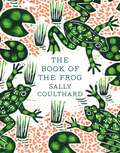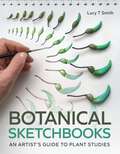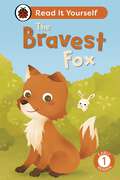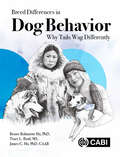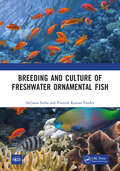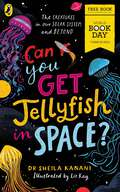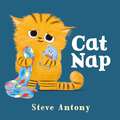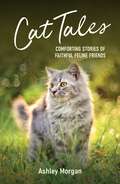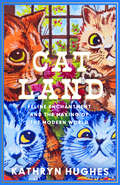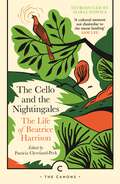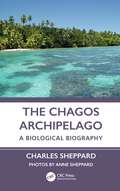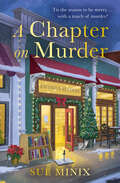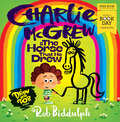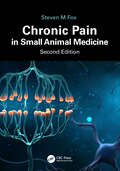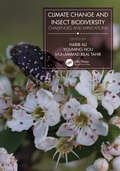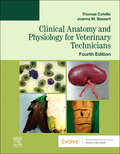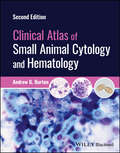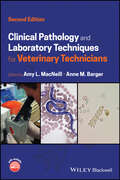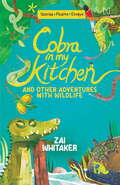- Table View
- List View
The Book of the Frog
by Sally CoulthardFrogs are extraordinary creatures. Unlike most other animals, they have mastered both land and water, and are capable of breathing through their skins and their lungs. Some of them are so poisonous that just one tiny frog harbours enough toxins to kill ten people stone dead, while others have held the key to lifesaving medicines and treatments, including the world's first pregnancy tests and cures for skin cancer. Cultures have loved and loathed frogs in equal measure, hailing them both as symbols of fertility and evil witches' familiars.Packed with beautiful illustrations and brimming with interesting facts, Sally Coulthard presents how frogs have successfully colonised some of the most challenging terrains on the planet. From the frozen Arctic to the parched South African desert, adopting bizarre and miraculous breeding strategies in the process: gastric-brooding frogs raise offspring in their stomachs, while in another species the froglets erupt from their mother's skin rather than growing from tadpoles.In The Book of the Frog, Sally Coulthard leaps into the cultural and natural history of frogs. Covering both familiar native British species and exotic rarities, she shares her fascination for these much-admired but often little understood creatures, many of which face threats and conservation challenges. From frogspawn and froglets to eating habits and hibernation, The Book of the Frog serves as the perfect jumping off point for anyone who loves amphibians.
Botanical Sketchbooks: An Artist's Guide to Plant Studies
by Lucy SmithThis inspirational guide explains how a botanical sketchbook can take many forms and hold different meanings. It shows how a sketchbook can be used as a workbook to study plants through drawing and painting in a variety of media. It includes examples of preliminary work for finished pieces, experiments in colour and exploration of plant anatomy, and shows how these studies can be made away from the pressure of creating the perfect, polished piece of final botanical artwork. It goes on to feature sketchbooks created for their own sake as a curated space for an artist to draw and record plants over a period of time, or a particular place.
The Bravest Fox: Read It Yourself - Level 1 Early Reader (Read It Yourself)
by LadybirdFox friends Kip and Tip love playing in the wood. They try to see who can jump the highest or the furthest, but who is actually the bravest fox in the end?The Bravest Fox is from Early Reader Level 1 and is perfect for children aged from 4+ who are taking their first steps beyond phonics.Each book has been carefully checked by educational and subject consultants and includes comprehension puzzles, book band information, and tips for helping children with their reading.With five levels to take children from first phonics to fluent reading and a wide range of different stories and topics for every interest, Read It Yourself helps children build their confidence and begin reading for pleasure
Breed Differences in Dog Behavior: Why Tails Wag Differently
by Dr Renee R. Ha Tracy L. Brad Dr James C. HaHumans have bred dogs for physical and behavioral characteristics for millennia. These efforts can have unintended side effects, however, which may be either advantageous or cause issues - such as a predisposition to certain medical complaints, or, controversially, behavioural issues. The scientific study of domestic dogs is still in its infancy, but public demand for this information is at a record high as more and more pet owners seek to understand their canine family members. Focusing on the behavioral differences and tendencies that have arisen in different breed lines, this book explores, summarizes, and explains the scientific evidence on what breed can tell us about behaviour - and, crucially, what it cannot. This book covers: - the impact of inbreeding, how it contributes to problematic behavioral issues such as anxiety and aggression, and how it potentially affects the future health of the breed; - the limits of predicting a dog's behavior based upon breed, individual differences within breeds, and thus the corresponding limitations of breed-specific legislation; - guidance for professionals to help their clients better understand behavioral issues, traits, and appropriate expectations around the right breed for their household. Providing a comprehensive and approachable view of the science behind breed-specific behaviors, this book gives dog enthusiasts from all professional and personal backgrounds a better understanding of why dogs do what they do, and how we can improve our relationships with our canine companions. Covering genetics, phylogeny of canids, temperament, aggression, social behavior, and the history of dog breeding, it is an important read for researchers, students, veterinary practitioners and animal behaviourists, as well as shelter staff, dog trainers, or anyone looking for a greater understanding of dog breed differences.
Breeding and Culture of Freshwater Ornamental Fish
by Archana Sinha Pramod Kumar PandeyThis book deals with recent and upcoming technologies of breeding freshwater ornamental fish. It covers in detail areas such as status, breeding techniques, food and health management and marketing of freshwater ornamental fishes. There is a separate chapter on breeding of indigenous freshwater ornamental fishes. Emphasis is given on national and international legislation related to ornamental fish export and import. The book contains a useful chapter on the importance and role of ornamental plants and accessories. Aquarium making, decoration, water quality management and maintenance have also been well explained for hobbyists. This title has been co-published with NIPA. Not for sale in South Asia (India, Sri Lanka, Nepal, Bangladesh, Pakistan and Bhutan)
Breeding and Culture of Freshwater Ornamental Fish
by Archana Sinha Pramod Kumar PandeyThis book deals with recent and upcoming technologies of breeding freshwater ornamental fish. It covers in detail areas such as status, breeding techniques, food and health management and marketing of freshwater ornamental fishes. There is a separate chapter on breeding of indigenous freshwater ornamental fishes. Emphasis is given on national and international legislation related to ornamental fish export and import. The book contains a useful chapter on the importance and role of ornamental plants and accessories. Aquarium making, decoration, water quality management and maintenance have also been well explained for hobbyists. This title has been co-published with NIPA. Not for sale in South Asia (India, Sri Lanka, Nepal, Bangladesh, Pakistan and Bhutan)
Can You Get Jellyfish in Space? (World Book Day 2024)
by Dr Sheila KananiYou've probably heard of dogs in space. Maybe even chimpanzees. But jellyfish? Almost certainly not!Join Dr Sheila Kanani in this special World Book Day adventure, as she discovers a weird and wonderful cast of animals who have travelled into space, from Ham the chimpanzee to Félicette the cat, and the 60,000 jellyfish who have orbited the Earth (did you know you can also get jellyfish-shaped galaxies?). You'll meet the microscopic creatures that can survive in the vacuum of space, and wonder – could aliens really exist?This fantastical journey into the wild and surprising realms of space weaves together astronomy, physics and biology, and is sure to inspire space-obsessed and animal-loving kids everywhere.
Cat Nap
by Steve AntonyMeet a cat, in need of a nap! The start of an exciting new picture book series for young children - and their parents! From award-winning author and illustrator, Steve Antony.Cat Nap marks the launch of a new, young, character-led picture book series from award-winning Steve Antony, the best-selling creator of Please Mr Panda, a series that has sold over 1 million copies Worldwide!This little cat needs a nap, but it’s hard to find time for sleep when you’re busy playing! Will he ever close his eyes?Style, simplicity and humour combine to make this original and engaging look at naptime a real must-have for all young children and their grown-ups. Fresh, funny and utterly relatable, with a playful, pitch-perfect text. The start of a brilliant new series that will delight young and old, from an undeniable picture book talent.For more toddler milestone moments:Bird BathHippo PottyChick Pea
Cat Tales: Comforting Stories of Faithful Feline Friends
by Ashley MorganThese uplifting stories share true accounts of some extra special cats and reminds us that even the smallest creatures can have the biggest impact on our lives. Whether you're a cat owner or simply appreciate the magic of these adorable creatures, this book is sure to warm your heart and remind you of the power of their love and companionship.
Catland: Feline Enchantment and the Making of the Modern World
by null Kathryn Hughes'Remarkable' Literary Review 'Startlingly original' Amanda Foreman Some called it a craze. To others it was a cult. Join prize-winning historian Kathryn Hughes to discover how Britain fell in love with cats and ushered in a new era. ‘He invented a whole cat world’ declared H. G. Wells of Louis Wain, the Edwardian artist whose anthropomorphic kittens made him a household name. His drawings were irresistible but Catland was more than the creation of one eccentric imagination. It was an attitude – a way of being in society while discreetly refusing to follow its rules. As cat capitalism boomed in the spectacular Edwardian age, prized animals changed hands for hundreds of pounds and a new industry sprung up to cater for their every need. Cats were no longer basement-dwelling pest-controllers, but stylish cultural subversives, more likely to flaunt a magnificent ruff and a pedigree from Persia. Wherever you found old conventions breaking down, there was a cat at the centre of the storm. Whether they were flying aeroplanes, sipping champagne or arguing about politics, Wain’s feline cast offered a sly take on the restless and risky culture of the post-Victorian world. No-one experienced these uncertainties more acutely than Wain himself, confined to a mental asylum while creating his most iconic work. Catland is a fascinating and fabulous unravelling of our obsession with cats, and the man dedicated to chronicling them. 'If a Louis Wain cat were reading this book, he would raise his topper in tribute’ The Times 'Brilliantly researched and unforgettable' Miranda Seymour 'Consistently fascinating … A tremendous literary feat in which we learn about Victorian sociology through the work of a remarkably unique artist' Kirkus, starred review
The Cello and the Nightingales: The Life of Beatrice Harrison (Canons)
by Beatrice Harrison Patricia Cleveland-PeckIn 1924, Beatrice Harrison broadcast a miracle to the world: a wild nightingale singing with her cello. Over a million people tuned in to hear the nightingale that night, and the BBC went on to broadcast their duet worldwide every spring until 1942. This transformed the public interest in nightingales – a species already in decline. If Beatrice’s duets with the nightingales touched a chord with the world, her own life proved to be as musical, free-spirited and inspiring. From her early years as a musical prodigy to recording with the most important composers of the day or playing for the wounded in the Second World War, Beatrice’s warmth and love for sharing music are as endearing now as they were to her original audiences.
The Chagos Archipelago: A Biological Biography
by Charles SheppardThis book is the story of the natural history of Chagos Archipelago, and of the efforts of many to get it recognized as an important and protected wildlife reserve. Exploring its immense natural riches and biodiversity, both on islands and in the marine environment, this book addresses competing claims to its resources, its politics, and the desire of some commercial and political parties to exploit the area. It is about the fight to conserve a wonderland of biodiversity and obtain its protection from exploitation, especially of its reefs and other marine life. This book shows the importance of the Chagos Archipelago and why so much research was done there. Rather than being a typical research book, this work presents research in a narrative form and describes the now substantial Government, UN, and legal interest in the archipelago since the UK was told to ‘decolonise’ it. It is also the story of our planet in miniature: the archipelago encapsulates much of the world’s conservation tribulations in a way we can much more easily understand. This narrative will explore the difficulties faced by the Chagos Archipelago, including displaced people, old and derelict industries (coconut in this case), the military, politics, rich and untouched ecosystems that some want to exploit, ruined habitats on land, climate change, and territorial claims. It will examine how all of these factors have affected the natural history, biodiversity, and conservation of the archipelago. With beautiful photography of the Chagos Archipelago coral reefs and islands, as well as graphs indicating their findings, this book offers professionals, researchers, academics, and students in conservation and biodiversity an insight into one of the world’s most diverse ecosystems. It is also accessible for non‑academic readers with an interest in climate change, biodiversity, and the importance of conservation.
The Chagos Archipelago: A Biological Biography
by Charles SheppardThis book is the story of the natural history of Chagos Archipelago, and of the efforts of many to get it recognized as an important and protected wildlife reserve. Exploring its immense natural riches and biodiversity, both on islands and in the marine environment, this book addresses competing claims to its resources, its politics, and the desire of some commercial and political parties to exploit the area. It is about the fight to conserve a wonderland of biodiversity and obtain its protection from exploitation, especially of its reefs and other marine life. This book shows the importance of the Chagos Archipelago and why so much research was done there. Rather than being a typical research book, this work presents research in a narrative form and describes the now substantial Government, UN, and legal interest in the archipelago since the UK was told to ‘decolonise’ it. It is also the story of our planet in miniature: the archipelago encapsulates much of the world’s conservation tribulations in a way we can much more easily understand. This narrative will explore the difficulties faced by the Chagos Archipelago, including displaced people, old and derelict industries (coconut in this case), the military, politics, rich and untouched ecosystems that some want to exploit, ruined habitats on land, climate change, and territorial claims. It will examine how all of these factors have affected the natural history, biodiversity, and conservation of the archipelago. With beautiful photography of the Chagos Archipelago coral reefs and islands, as well as graphs indicating their findings, this book offers professionals, researchers, academics, and students in conservation and biodiversity an insight into one of the world’s most diverse ecosystems. It is also accessible for non‑academic readers with an interest in climate change, biodiversity, and the importance of conservation.
A Chapter on Murder (The Bookstore Mystery Series)
by Sue MinixI loved writing murder mysteries, until I was thrust into the centre of one …
Charlie McGrew & the Horse that he Drew (World Book Day 2024)
by Rob BiddulphCharlie McGrew longs for a clippety companion but the sign says NO PETS – can he draw one instead? World Book Day 2024
Chronic Pain in Small Animal Medicine
by Steven M. FoxOver the past decade, since publication of the first edition of Chronic Pain in Small Animal Medicine, many advances have been made in the discipline of pain management, including embracement under the One Medicine initiative to improve the health and well-being of multiple species. Contributing significantly to this progress is the evidence base provided by multimodal management of chronic diseases such as osteoarthritis, a leading cause of pet euthanasia. These advances are explored in this updated edition, written for the veterinary professional seeking a greater depth of knowledge in the mechanisms of pain accompanying chronic disease states and the potential targets for treatment. Additional new sections describe newer drugs that are now in wide use, the Canine Osteoarthritis Staging Tool (COAST), novel approaches to cancer treatment, and cannabinoids and their functions. The book goes beyond common protocols by focusing on the latest evidence and our understanding of 'why and how to treat'. It describes and evaluates current physiological and biochemical theories of pain transmission without losing sight of the practical need for such information. Chronic Pain in Small Animal Medicine provides a foundation for advances in animal care and welfare and is necessary reading for veterinarians in practice and training. We’re living in an age of exciting, new discoveries, but these are only exciting if we are aware of these offerings and their optimal indications for use. This book aims to open veterinarians' eyes to the myriad new ways we can now treat chronic pain in small animals.
Chronic Pain in Small Animal Medicine
by Steven M. FoxOver the past decade, since publication of the first edition of Chronic Pain in Small Animal Medicine, many advances have been made in the discipline of pain management, including embracement under the One Medicine initiative to improve the health and well-being of multiple species. Contributing significantly to this progress is the evidence base provided by multimodal management of chronic diseases such as osteoarthritis, a leading cause of pet euthanasia. These advances are explored in this updated edition, written for the veterinary professional seeking a greater depth of knowledge in the mechanisms of pain accompanying chronic disease states and the potential targets for treatment. Additional new sections describe newer drugs that are now in wide use, the Canine Osteoarthritis Staging Tool (COAST), novel approaches to cancer treatment, and cannabinoids and their functions. The book goes beyond common protocols by focusing on the latest evidence and our understanding of 'why and how to treat'. It describes and evaluates current physiological and biochemical theories of pain transmission without losing sight of the practical need for such information. Chronic Pain in Small Animal Medicine provides a foundation for advances in animal care and welfare and is necessary reading for veterinarians in practice and training. We’re living in an age of exciting, new discoveries, but these are only exciting if we are aware of these offerings and their optimal indications for use. This book aims to open veterinarians' eyes to the myriad new ways we can now treat chronic pain in small animals.
Climate Change and Insect Biodiversity: Challenges and Implications
This up-to-date reference book discusses the effects of climate change on the biodiversity of insect pests. The changing climate and agricultural intensification practices impact negatively on insect biodiversity. The book explains the significance of insect pests for evaluating climatic impacts on a wide range of ecological systems. It covers the effect of climate change on pollinators and household and agricultural insect pests. It explains how climate-smart agriculture can enhance productivity and food security.FEATURES Reviews the effects of climate change on plant-insect interactions Includes topics such as insect biodiversity informatics and conservation Discusses food security, pest management, and beneficial and social insects Covers topics such as precision agriculture and climate-smart agriculture Provides insights on the relation between agriculture intensification and insect biodiversity This book is meant for scientists, researchers, and students working in the fields of agriculture, entomology, ecology, plant science, environmental biology, and biotechnology.
Climate Change and Insect Biodiversity: Challenges and Implications
by Habib Ali Youming Hou Muhammad Bilal TahirThis up-to-date reference book discusses the effects of climate change on the biodiversity of insect pests. The changing climate and agricultural intensification practices impact negatively on insect biodiversity. The book explains the significance of insect pests for evaluating climatic impacts on a wide range of ecological systems. It covers the effect of climate change on pollinators and household and agricultural insect pests. It explains how climate-smart agriculture can enhance productivity and food security.FEATURES Reviews the effects of climate change on plant-insect interactions Includes topics such as insect biodiversity informatics and conservation Discusses food security, pest management, and beneficial and social insects Covers topics such as precision agriculture and climate-smart agriculture Provides insights on the relation between agriculture intensification and insect biodiversity This book is meant for scientists, researchers, and students working in the fields of agriculture, entomology, ecology, plant science, environmental biology, and biotechnology.
Clinical Anatomy and Physiology for Veterinary Technicians - E-Book
by Thomas P. Colville Joanna M. BassertStart your veterinary technician education off on the right foot with Clinical Anatomy and Physiology for Veterinary Technicians, 4th Edition. Combining expert clinical coverage with engaging writing and vivid illustrations, this popular text is the key to understanding the anatomic and physiologic principles that will carry you throughout your career. In addition to its comprehensive coverage of the diverse ways in which animal bodies function at both the systemic and cellular levels, this textbook features a variety of helpful application boxes, vocabulary lists, and Test Yourself questions in every chapter to ensure you have a firm grasp of anatomic structure and its relevance to clinical practice. Clinical Application boxes throughout the text demonstrate the clinical relevance of anatomic and physiologic principles. Chapter outlines summarize the contents of each chapter at the major concept level. Test Yourself questions recap important information that appeared in the preceding section. Comprehensive glossary at the end of the text provides concise definitions and phonetic pronunciations of terms. NEW and UPDATED! Hundreds of high-quality, full color illustrations detail anatomic structures to enhance your understanding of their functions. NEW! Student chapter review questions on the Evolve companion website help reinforce key topics in each chapter.
Clinical Atlas of Small Animal Cytology and Hematology
by Andrew G. BurtonClinical Atlas of Small Animal Cytology and Hematology A comprehensive image-based reference to all aspects of small animal cytology and hematology, including sample collection and handling Clinical Atlas of Small Animal Cytology and Hematology, Second Edition is an essential, comprehensive resource for all veterinary professionals preparing and evaluating cytology and blood samples. Featuring hundreds of large, high-quality images, this fully updated new edition provides an even more extensive collection of exceptional photomicrographs, accompanied by detailed descriptions, figure legends and annotations to guide readers through the diagnostic process. The Second Edition adds an extensive new hematology section, new chapters detailing sample acquisition and preparation, and many new diseases across all chapters. Each section provides a detailed description of the microscopic appearance, clinical considerations, and prognosis for each disease, using a bullet point format to promote rapid review for efficient, evidence-based clinical decision making. Clinical Atlas of Small Animal Cytology and Hematology features: More than 750 high-quality cytology and hematology images 6 new chapters, including detailed sections on sample acquisition and the preparation and staining of cytology and hematology slides A comprehensive hematology section including an easy-to-follow blood smear interpretation guide, and detailed chapters describing erythrocytes, leukocytes, platelets and background features Updated cytology sections with new diseases and images in all chapters Easy to use, with superior quality images and detailed yet succinct clinical information, Clinical Atlas of Small Animal Cytology and Hematology is a powerful resource to help improve confidence and skill in the interpretation of cytology and hematology samples, and in turn positively impact patient care and outcomes.
Clinical Atlas of Small Animal Cytology and Hematology
by Andrew G. BurtonClinical Atlas of Small Animal Cytology and Hematology A comprehensive image-based reference to all aspects of small animal cytology and hematology, including sample collection and handling Clinical Atlas of Small Animal Cytology and Hematology, Second Edition is an essential, comprehensive resource for all veterinary professionals preparing and evaluating cytology and blood samples. Featuring hundreds of large, high-quality images, this fully updated new edition provides an even more extensive collection of exceptional photomicrographs, accompanied by detailed descriptions, figure legends and annotations to guide readers through the diagnostic process. The Second Edition adds an extensive new hematology section, new chapters detailing sample acquisition and preparation, and many new diseases across all chapters. Each section provides a detailed description of the microscopic appearance, clinical considerations, and prognosis for each disease, using a bullet point format to promote rapid review for efficient, evidence-based clinical decision making. Clinical Atlas of Small Animal Cytology and Hematology features: More than 750 high-quality cytology and hematology images 6 new chapters, including detailed sections on sample acquisition and the preparation and staining of cytology and hematology slides A comprehensive hematology section including an easy-to-follow blood smear interpretation guide, and detailed chapters describing erythrocytes, leukocytes, platelets and background features Updated cytology sections with new diseases and images in all chapters Easy to use, with superior quality images and detailed yet succinct clinical information, Clinical Atlas of Small Animal Cytology and Hematology is a powerful resource to help improve confidence and skill in the interpretation of cytology and hematology samples, and in turn positively impact patient care and outcomes.
Clinical Pathology and Laboratory Techniques for Veterinary Technicians
by Amy L. MacNeill Anne M. BargerClinical Pathology and Laboratory Techniques for Veterinary Technicians Up-to-date, practical reference book demonstrating laboratory procedures in dogs, cats, cattle and horses The newly revised and updated Second Edition of Clinical Pathology and Laboratory Techniques for Veterinary Technicians is an inclusive reference on laboratory procedures pertaining to small animals, horses, and cattle, providing information on hematology, hemostasis, clinical chemistry, urinalysis, parasitology, endocrine testing, and quality assurance. The text clarifies ‘how-to’ information while also discussing the importance of ‘why’ laboratory procedures are performed in a particular way, enabling readers to gain true understanding of the topics discussed. To aid in reader comprehension, high-quality photographs labeled with magnification and stain information, which clearly depict cellular morphology, inclusions, and infectious organisms, are included throughout each chapter. The text also offers key objectives, technician tip boxes, case examples, and a glossary of key terms, along with a companion website that provides instructor questions, and an answer key to multiple choice questions in the book. Clinical Pathology and Laboratory Techniques for Veterinary Technicians includes information on: Sample collection, handling, and quality assurance, to ensure laboratory test results are validHematology data collection techniques that may be used on a daily basis to evaluate the overall health of animal patientsClinical chemistry data to indicate organ function, covering how different chemicals measured in patient samples relate to the function of specific organs in the bodyIn-house parasitology procedures, with important advances in molecular diagnostics have been made that improve the detection and identification of parasitesInformation about common endocrinopathies and submission of samples for endocrine testing. With complete coverage of the subject, Clinical Pathology and Laboratory Techniques for Veterinary Technicians is an essential resource for students enrolled in veterinary technology programs and veterinary colleges, and may be used as a textbook to guide and supplement information provided in both didactic and laboratory-based clinical pathology courses.
Clinical Pathology and Laboratory Techniques for Veterinary Technicians
by Amy L. MacNeill Anne M. BargerClinical Pathology and Laboratory Techniques for Veterinary Technicians Up-to-date, practical reference book demonstrating laboratory procedures in dogs, cats, cattle and horses The newly revised and updated Second Edition of Clinical Pathology and Laboratory Techniques for Veterinary Technicians is an inclusive reference on laboratory procedures pertaining to small animals, horses, and cattle, providing information on hematology, hemostasis, clinical chemistry, urinalysis, parasitology, endocrine testing, and quality assurance. The text clarifies ‘how-to’ information while also discussing the importance of ‘why’ laboratory procedures are performed in a particular way, enabling readers to gain true understanding of the topics discussed. To aid in reader comprehension, high-quality photographs labeled with magnification and stain information, which clearly depict cellular morphology, inclusions, and infectious organisms, are included throughout each chapter. The text also offers key objectives, technician tip boxes, case examples, and a glossary of key terms, along with a companion website that provides instructor questions, and an answer key to multiple choice questions in the book. Clinical Pathology and Laboratory Techniques for Veterinary Technicians includes information on: Sample collection, handling, and quality assurance, to ensure laboratory test results are validHematology data collection techniques that may be used on a daily basis to evaluate the overall health of animal patientsClinical chemistry data to indicate organ function, covering how different chemicals measured in patient samples relate to the function of specific organs in the bodyIn-house parasitology procedures, with important advances in molecular diagnostics have been made that improve the detection and identification of parasitesInformation about common endocrinopathies and submission of samples for endocrine testing. With complete coverage of the subject, Clinical Pathology and Laboratory Techniques for Veterinary Technicians is an essential resource for students enrolled in veterinary technology programs and veterinary colleges, and may be used as a textbook to guide and supplement information provided in both didactic and laboratory-based clinical pathology courses.
Cobra in My Kitchen and Other Adventures with Wildlife
by Zai WhitakerROAR! HISS! SQUEAK! NYUK-NYUK!Wildlife sure sounds fun, doesn't it? Explore the wild with Zai Whitaker, an eager adventurer raised among India's pioneering conservation heroes! Together with Romulus Whitaker, the 'Snake Man of India', Zai developed the Madras Crocodile Bank, to research and conserve crocodiles and other 'herps'. From living with cobras as to hatching sea turtles and from watching birds to stalking termites, Zai has a long and thrilling trail of escapades. Her stories, poems and real-life accounts take you from Chennai to the Western Ghats, from the Andaman and Nicobar Islands to Papua New Guinea, and beyond into her wildly wonderful imagination! Beautifully illustrated, Cobra in my Kitchen and Other Adventures with Wildlife introduces you to the fascinating side of wriggly snakes, jumpy frogs, lively lizards, colourful chameleons and even a tiger or two, along with many more unmissable adventures! Hop on to this sensational safari of discoveries for children and the whole family!
